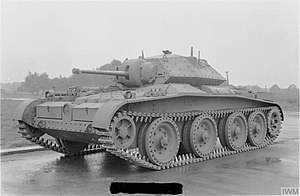Our website is made possible by displaying online advertisements to our visitors.
Please consider supporting us by disabling your ad blocker.
Covenanter tank
| Covenanter cruiser tank | |
|---|---|
 Tank, Cruiser, Mk V, Covenanter (A13 Mk III) | |
| Type | Cruiser tank |
| Place of origin | United Kingdom |
| Service history | |
| In service | 1940–1943 |
| Production history | |
| Designer | LMS/Nuffield (turret) |
| Manufacturer | LMS, English Electric Leyland Motors |
| Produced | 1939–1943 |
| No. built | 1,771 |
| Specifications | |
| Mass | 18 long tons (18 t)[1] |
| Length | 19 ft 0 in (5.79 m)[1] |
| Width | 8 ft 7 in (2.62 m)[1] |
| Height | 7 ft 4 in (2.24 m)[1] |
| Crew | 4 (commander, gunner, loader, driver) |
| Armour | 7–40 mm (0.28–1.57 in) |
Main armament | QF 2-pounder (40 mm) |
Secondary armament | 7.92 mm Besa machine gun (coaxial) 0.303 Bren light machine gun carried for AA defence |
| Engine | Meadows D.A.V flat-12 340 hp (250 kW) |
| Power/weight | 18.6 hp (13.9 kW) / tonne |
| Transmission | Meadows gearbox with Wilson epicyclic steering |
| Suspension | Christie |
| Fuel capacity | 92 imperial gallons (420 L)[2][3] |
Operational range | 100 mi (160 km)[1] |
| Maximum speed | 30 mph (48 km/h) |
The Cruiser tank Mk V or A13 Mk III Covenanter was a British cruiser tank of the Second World War. The Covenanter was the first cruiser tank design to be given a name. Designed by the London, Midland and Scottish Railway as a better-armoured replacement for the Cruiser Mark IV, it was ordered into production in 1939 before pilot models were built. Problems with the design became apparent only after production was under way.
The tank equipped various British armoured divisions for home defence and training. It never left the UK as poor engine cooling caused the Mk I to Mk III to be declared unfit for overseas service, especially in hot climates. This was rectified in the Mk IV after many corrective actions were undertaken but, by February 1944, it was declared obsolete. More than 1,700 of the type were built. It was named after the Covenanters, a Scottish religious and political movement at the time of the Wars of the Three Kingdoms.[citation needed]
Previous Page Next Page


